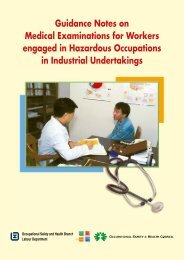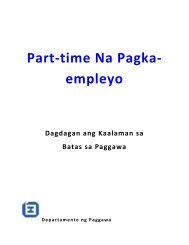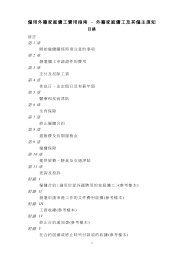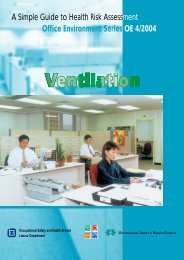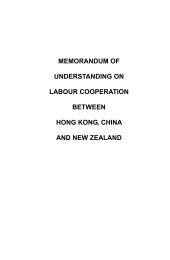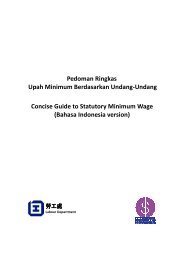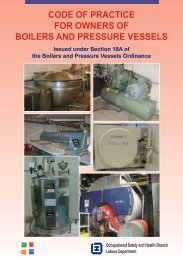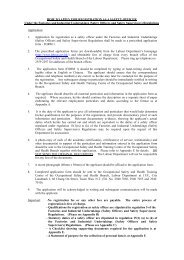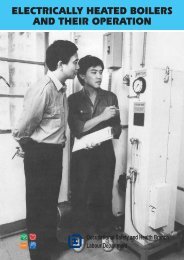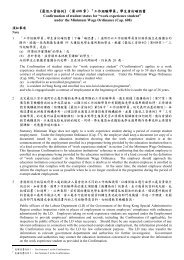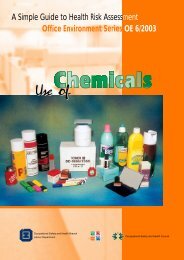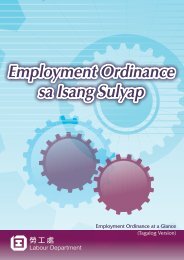Code of Practice for Safety and Health at
Code of Practice for Safety and Health at
Code of Practice for Safety and Health at
Create successful ePaper yourself
Turn your PDF publications into a flip-book with our unique Google optimized e-Paper software.
<strong>Code</strong> <strong>of</strong> <strong>Practice</strong><br />
<strong>Safety</strong> <strong>and</strong> <strong>Health</strong> <strong>at</strong> Work<br />
(L<strong>and</strong>-based Construction<br />
over W<strong>at</strong>er-Prevention <strong>of</strong> Fall)
This <strong>Code</strong> <strong>of</strong> <strong>Practice</strong> is prepared by the<br />
Occup<strong>at</strong>ional <strong>Safety</strong> <strong>and</strong> <strong>Health</strong> Branch<br />
Labour Department<br />
First Edition October 1999<br />
This <strong>Code</strong> <strong>of</strong> <strong>Practice</strong> is issued free <strong>of</strong> charge <strong>and</strong> can be obtained from<br />
<strong>of</strong>fices <strong>of</strong> the Occup<strong>at</strong>ional <strong>Safety</strong> <strong>and</strong> <strong>Health</strong> Branch. Addresses <strong>and</strong><br />
telephone numbers <strong>of</strong> the <strong>of</strong>fices can be found in the booklet “The Labour<br />
Department Offers You its Services” or by telephone 2559 2297.
CONTENT<br />
1. INTRODUCTION........................................................................................<br />
1.1 PURPOSE.................................................................................................................<br />
1.2 SCOPE......................................................................................................................<br />
2. INTERPRETATION....................................................................................<br />
3. RESPONSIBILITY......................................................................................<br />
4. MANAGING SAFETY AND HEALTH........................................................<br />
4.1 PROJECT PLANNING AND DESIGN........................................................................<br />
4.2 SELECTION OF CONTRACTOR OR SUB-CONTRACTOR.......................................<br />
4.3 RISK ASSESSMENT..................................................................................................<br />
4.4 METHOD STATEMENT..............................................................................................<br />
4.5 COORDINATION, COMMUNICATION AND SUPERVISION.....................................<br />
4.6 MONITORING SAFETY PERFORMANCE.................................................................<br />
4.7 CONTINGENCY PLAN FOR ADVERSE WEATHER CONDITIONS...........................<br />
4.8 TRAINING.................................................................................................................<br />
5. PREVENTION OF FALL............................................................................<br />
Page<br />
5.1 MOBILE PLANT......................................................................................................... 14<br />
5.2 KERB......................................................................................................................... 14<br />
5.3 GUARD-RAIL ........................................................................................................... 15<br />
5.4 PROTECTION AGAINST DROWNING...................................................................... 15<br />
5.5 WORKING PLATFORM............................................................................................. 15<br />
5.6 EDGE OVER WATER, GANGWAY OR RUN.............................................................. 16<br />
5.7 SAFETY NET............................................................................................................. 17<br />
5.8 SAFETY BELT/SAFETY HARNESS............................................................................ 20<br />
6. ACCESS AND EGRESS............................................................................ 21<br />
6.1 SAFE MEANS OF ACCESS AND EGRESS............................................................... 21<br />
6.2 ACCESS TO AND FROM VESSEL............................................................................ 22<br />
6.3 LADDER.................................................................................................................... 23<br />
7. GENERAL WORKPLACE ENVIRONMENT................................................... 24<br />
7.1 HOUSEKEEPING...................................................................................................... 24<br />
7.2 ILLUMINATION AND LIGHTING............................................................................... 24<br />
7.3 HEADROOM RESTRICTION..................................................................................... 25<br />
7.4 HEALTH AND HYGIENE........................................................................................... 25<br />
8. PERSONAL PROTECTIVE EQUIPMENT....................................................... 26<br />
8.1 FOOTWEAR.............................................................................................................. 26<br />
8.2 SAFETY HELMET......................................................................................................<br />
8.3 SAFETY BELT/SAFETY HARNESS............................................................................<br />
8.4 LIFEJACKET AND BUOYANCY AID.........................................................................<br />
1<br />
1<br />
2<br />
3<br />
5<br />
6<br />
6<br />
7<br />
7<br />
8<br />
9<br />
11<br />
11<br />
12<br />
14<br />
26<br />
26<br />
28
9. RESCUE AND EMERGENCY PROCEDURE................................................ 29<br />
APPENDIX I<br />
RELEVANT PROVISIONS OF THE FACTORIES AND INDUSTRIAL<br />
UNDERTAKINGS ORDINANCE, CHAPTER 59. .............................................. 34<br />
A1.1 SECTION 6A OF FACTORIES AND INDUSTRIAL UNDERTAKINGS ORDINANCE<br />
GENERAL DUTIES OF A PROPRIETOR...................................................................<br />
A1.2 SECTION 6B OF FACTORIES AND INDUSTRIAL UNDERTAKINGS ORDINANCE<br />
GENERAL DUTIES OF PERSONS EMPLOYED........................................................<br />
A1.3 REGULATION 52A OF CONSTRUCTION SITES (SAFETY) REGULATIONS<br />
PREVENTION OF DROWNING.................................................................................<br />
A1.4 THIRD SCHEDULE TO CONSTRUCTION SITES (SAFETY) REGULATIONS<br />
REQUIREMENTS WITH WHICH CERTAIN SAFETY EQUIPMENT MUST COMPLY..<br />
APPENDIX II<br />
STANDARD FOR EQUIPMENT.......................................................................... 39<br />
APPENDIX III<br />
REFERENCE...................................................................................................... 43<br />
FIGURE 1<br />
WHEEL-MOUNTED PLANT AT EDGE OF TEMPORARY EARTH SLOPE OVER WATER................<br />
FIGURE 2<br />
CRAWLER TRACK-MOUNTED PLANT AT EDGE OF TEMPORARY EARTH SLOPE OVER WATER<br />
FIGURE 3<br />
MOBILE PLANT AT EDGE OF PERMANENT SLOPE OVER WATER.................................................. 46<br />
FIGURE 4<br />
9.1 RESCUE TEAM......................................................................................................... 29<br />
9.2 FIRST AID FACILITY................................................................................................. 29<br />
9.3 EMERGENCY PROCEDURE................................................................................... 30<br />
9.4 RESCUE EQUIPMENT.............................................................................................. 31<br />
9.5 RESCUE BOAT......................................................................................................... 32<br />
A TYPICAL SCHEMATIC ARRANGEMENT OF SAFETY NET OUTRIGGED FROM SCAFFOLDING<br />
ENQUIRY............................................................................................................. 48<br />
34<br />
35<br />
35<br />
36<br />
44<br />
45<br />
47
1. INTRODUCTION<br />
1.1 Purpose<br />
1.1.1 This <strong>Code</strong> <strong>of</strong> <strong>Practice</strong> provides practical guidance <strong>and</strong> gives<br />
recommend<strong>at</strong>ions on the safety <strong>and</strong> health practices <strong>at</strong> work <strong>for</strong><br />
l<strong>and</strong>-based construction work carried out on, adjacent to or over<br />
w<strong>at</strong>er where drowning hazard to workmen exists. It is intended to<br />
be read by contractors, supervisors, proprietors <strong>and</strong> safety personnel<br />
<strong>of</strong> industrial undertakings in which l<strong>and</strong>-based construction over<br />
w<strong>at</strong>er are involved. The dangers involved include slipping, falling or<br />
sweeping workmen away by waves. Duties <strong>of</strong> the proprietors <strong>and</strong><br />
the employees to ensure the safety <strong>and</strong> health <strong>of</strong> such a workplace<br />
are stipul<strong>at</strong>ed in Sections 6A <strong>and</strong> 6B <strong>of</strong> the Factories <strong>and</strong> Industrial<br />
Undertakings Ordinance, Cap. 59 <strong>of</strong> the Laws <strong>of</strong> Hong Kong <strong>and</strong><br />
the Construction Sites (<strong>Safety</strong>) Regul<strong>at</strong>ions made thereunder.<br />
1.1.2 The <strong>Code</strong> <strong>of</strong> <strong>Practice</strong> is approved <strong>and</strong> issued by the Commissioner<br />
<strong>for</strong> Labour under Section 7A <strong>of</strong> the Factories <strong>and</strong> Industrial<br />
Undertakings Ordinance. The recommend<strong>at</strong>ions contained in the<br />
<strong>Code</strong> <strong>of</strong> <strong>Practice</strong> should not be regarded as exhausting those m<strong>at</strong>ters<br />
which need to be covered by the relevant safety legisl<strong>at</strong>ion.<br />
Compliance with the <strong>Code</strong> <strong>of</strong> <strong>Practice</strong> does not confer immunity<br />
from relevant legal requirements.<br />
1.1.3 Although failure to observe any provision <strong>of</strong> the <strong>Code</strong> <strong>of</strong> <strong>Practice</strong> is<br />
not itself an <strong>of</strong>fence, th<strong>at</strong> failure may be taken by a court in criminal<br />
proceedings as a relevant factor in determining whether a person<br />
has breached the relevant safety <strong>and</strong> health legisl<strong>at</strong>ion under the<br />
Factories <strong>and</strong> Industrial Undertakings Ordinance or not. It will then<br />
be open to th<strong>at</strong> person to s<strong>at</strong>isfy the court th<strong>at</strong> he has complied with<br />
the legisl<strong>at</strong>ion in some other way.<br />
1.1.4 Throughout the <strong>Code</strong>, we will quote the relevant safety st<strong>and</strong>ards <strong>of</strong><br />
the British St<strong>and</strong>ards Institution. However, other n<strong>at</strong>ional, intern<strong>at</strong>ional<br />
1
st<strong>and</strong>ards or provisions which are equivalent to the British st<strong>and</strong>ards<br />
may be acceptable as altern<strong>at</strong>ives.<br />
1.1.5 The st<strong>at</strong>utory provisions summarised or referred to in the <strong>Code</strong> are<br />
the provisions in <strong>for</strong>ce on 15th October 1999.<br />
1.1.6 The Commissioner <strong>for</strong> Labour is gr<strong>at</strong>eful to the British St<strong>and</strong>ards<br />
Institution <strong>for</strong> permission to make reference to the British st<strong>and</strong>ards<br />
in the prepar<strong>at</strong>ion <strong>of</strong> this <strong>Code</strong> <strong>of</strong> <strong>Practice</strong>.<br />
1.2 Scope<br />
1.2.1 This <strong>Code</strong> <strong>of</strong> <strong>Practice</strong> recommends safe practices <strong>for</strong> the prevention<br />
<strong>of</strong> fall in l<strong>and</strong>-based construction work carried out on, adjacent to or<br />
over w<strong>at</strong>er where drowning hazard to workmen exists.<br />
1.2.2 This <strong>Code</strong> <strong>of</strong> <strong>Practice</strong> does not apply to work rel<strong>at</strong>ed to marine<br />
safety*, sea-based construction work, nor to work other than<br />
construction work.<br />
* Guidelines on marine safety are available from the Marine Department.<br />
2
3. RESPONSIBILITY<br />
3.1 Securing safety <strong>and</strong> health <strong>at</strong> work on a construction site requires<br />
full commitment <strong>and</strong> co-oper<strong>at</strong>ion <strong>of</strong> every body concerned. A<br />
proprietor (or a contractor) should ensure the safety <strong>and</strong> health <strong>of</strong><br />
all his workmen so far as is reasonably practicable.<br />
The proprietor (or the contractor) <strong>of</strong>ten employs management<br />
personnel to discharge his duties <strong>and</strong> responsibilities <strong>for</strong><br />
management or control <strong>of</strong> the construction site. Under the FIUO,<br />
the management personnel who have management or control <strong>of</strong><br />
the construction site are regarded as the proprietor. The management<br />
personnel, who may include managers, agents, engineers or<br />
<strong>for</strong>emen, there<strong>for</strong>e, should take care <strong>of</strong> the safety <strong>and</strong> health <strong>of</strong> the<br />
workmen so far as is reasonably practicable. In this connection, the<br />
authority <strong>and</strong> responsibility <strong>for</strong> each member <strong>of</strong> the management<br />
personnel should be precisely set down.<br />
3.2 Every person employed in an undertaking, including management<br />
personnel <strong>and</strong> the workmen, is himself an employee. He is required<br />
to co-oper<strong>at</strong>e with the proprietor (or the contractor) <strong>and</strong> other<br />
employees to take reasonable care <strong>for</strong> the safety <strong>and</strong> health <strong>of</strong> not<br />
only himself, but also <strong>of</strong> other persons who may be affected by his<br />
acts or omissions <strong>at</strong> work.<br />
3.3 It is important to note th<strong>at</strong> under the CS(S)R, the contractor<br />
responsible <strong>for</strong> a construction site is required to ensure the safety <strong>of</strong><br />
every workplace on the site.<br />
3.4 The responsibilities <strong>of</strong> the proprietor (or the contractor) <strong>and</strong> <strong>of</strong> the<br />
employees involved in construction work have been defined in the<br />
FIUO <strong>and</strong> its subsidiary legisl<strong>at</strong>ion, in particular Sections 6A <strong>and</strong><br />
6B <strong>of</strong> the FIUO <strong>and</strong> Regul<strong>at</strong>ion 52A <strong>and</strong> the Third Schedule to the<br />
CS(S)R. The relevant provisions are listed in Appendix I <strong>for</strong> easy<br />
reference.<br />
5
4. MANAGING SAFETY AND<br />
HEALTH<br />
It is the responsibility <strong>of</strong> the proprietor (or the contractor) to provide<br />
a safe system <strong>of</strong> work <strong>for</strong> the safety <strong>and</strong> health <strong>at</strong> work <strong>of</strong> his<br />
workmen. To achieve this, it calls <strong>for</strong> a good safety management<br />
system. Among other things, the following actions should be taken :-<br />
4.1 Project planning <strong>and</strong> design<br />
4.1.1 A construction project should be designed with safety in mind. This<br />
approach makes it possible to elimin<strong>at</strong>e or minimize work hazards<br />
by proper planning <strong>and</strong> design <strong>of</strong> the methods <strong>of</strong> construction,<br />
sequences <strong>of</strong> activities, coordin<strong>at</strong>ion, etc.<br />
4.1.2 Potentially hazardous or unfavourable site conditions which will likely<br />
affect the safety <strong>of</strong> the workplace should be considered in the<br />
planning <strong>and</strong> design <strong>of</strong> the construction project. These may include<br />
the following :-<br />
a) sites with strong tides, winds or waves;<br />
b) sites which are too remote from the city centre or hospitals;<br />
c) sites which have restricted space <strong>for</strong> manoeuvring, such as<br />
those <strong>for</strong> temporary storage;<br />
d) the activities <strong>of</strong> other contractors including sub-contractors<br />
within the sites;<br />
e) adjacent maritime activities; <strong>and</strong><br />
f) emission <strong>of</strong> noise, toxic gases, harmful chemicals or dust from<br />
processes on or around the sites.<br />
6
4.2 Selection <strong>of</strong> contractor or sub-contractor<br />
4.2.1 In order to ensure th<strong>at</strong> the contractor or sub-contractor will make<br />
adequ<strong>at</strong>e provision <strong>for</strong> safety <strong>and</strong> health, their ability to provide a<br />
good action plan on safety should be taken into consider<strong>at</strong>ion in<br />
deciding the award <strong>of</strong> contracts.<br />
4.2.2 During the process <strong>of</strong> selection, tenderers or prospective contractors<br />
should be encouraged to submit an outline action plan on safety,<br />
giving preliminary in<strong>for</strong>m<strong>at</strong>ion to demonstr<strong>at</strong>e the intended safe<br />
system <strong>of</strong> work. Depending on the complexity <strong>of</strong> the project, the<br />
outline action plan on safety should briefly describe items such as<br />
safety organis<strong>at</strong>ion, communic<strong>at</strong>ion, monitoring, equipment,<br />
facilities, emergency procedures, accident reporting <strong>and</strong> accident<br />
investig<strong>at</strong>ion procedures.<br />
4.2.3 After the contractor or sub-contractor has been appointed, he should<br />
be required to submit a detailed action plan on safety on the basis<br />
<strong>of</strong> the outline action plan, if any, <strong>for</strong> agreement in writing. The action<br />
plan on safety should spell out the ways <strong>and</strong> means to carry out<br />
work safely <strong>and</strong> effectively in order to achieve the objective <strong>of</strong><br />
ensuring the safety <strong>and</strong> health <strong>of</strong> workmen <strong>at</strong> work.<br />
4.3 Risk assessment<br />
4.3.1 Risk assessment is the overall process <strong>of</strong> estim<strong>at</strong>ing the magnitude<br />
<strong>of</strong> risk <strong>and</strong> deciding whether or not the risk is tolerable or acceptable.<br />
Its main purpose is to determine whether the as-planned or existing<br />
controls are adequ<strong>at</strong>e so th<strong>at</strong> risks are controlled <strong>and</strong> harm can be<br />
avoided. Risk assessment should be conducted be<strong>for</strong>e any new<br />
work starts, <strong>and</strong> it should be reviewed periodically.<br />
4.3.2 Risk assessment can be divided into 5 basic steps as follows :<br />
7
Step 1 - Identify the hazards in the workplace.<br />
Step 2 - Identify who or wh<strong>at</strong> may be harmed, <strong>and</strong> how such harm<br />
may occur.<br />
Step 3 - Assess the risks arising from the hazards based on the<br />
probability <strong>and</strong> the possible consequences <strong>of</strong> the<br />
hazardous event, <strong>and</strong> assess whether the existing safety<br />
precautions are adequ<strong>at</strong>e <strong>and</strong> wh<strong>at</strong> more should be done.<br />
Step 4 - Record the findings <strong>of</strong> the assessment.<br />
Step 5 - Review the assessment from time to time <strong>and</strong> revise it if<br />
necessary.<br />
4.4 Method st<strong>at</strong>ement<br />
4.4.1 A method st<strong>at</strong>ement should be prepared by a competent person.<br />
The person should have adequ<strong>at</strong>e training <strong>and</strong> practical experience<br />
<strong>and</strong> be capable <strong>of</strong> making recommend<strong>at</strong>ions on safe methods as<br />
required in 4.4.2 <strong>and</strong> 4.4.3 below. In preparing a method st<strong>at</strong>ement<br />
on temporary works, the person should also be capable <strong>of</strong> making<br />
decisions on whether the loads on the works in progress can be<br />
resisted safely without undue movements.<br />
4.4.2 The method st<strong>at</strong>ement should contain written instructions regarding<br />
the technical aspects <strong>of</strong> the construction processes <strong>and</strong> how works<br />
can be carried out safely as designed. It should be well documented<br />
to ensure th<strong>at</strong> everybody involved in the construction processes is<br />
aware <strong>of</strong> wh<strong>at</strong> to do. It should be distributed to all parties concerned<br />
in the language(s) understood by them be<strong>for</strong>e works commence.<br />
4.4.3 <strong>Safety</strong> measures required to be taken in per<strong>for</strong>ming the activities<br />
safely should be incorpor<strong>at</strong>ed into the method st<strong>at</strong>ement. Depending<br />
on the n<strong>at</strong>ure, size <strong>and</strong> complexity <strong>of</strong> the work, a method st<strong>at</strong>ement<br />
8
should where appropri<strong>at</strong>e include :-<br />
a) arrangement <strong>for</strong> coordin<strong>at</strong>ion, responsibilities <strong>and</strong> authority <strong>of</strong><br />
management personnel during the progress <strong>of</strong> the work;<br />
b) layout, support details <strong>and</strong> construction details <strong>of</strong> all temporary<br />
works including falseworks (the strength <strong>and</strong> stability <strong>of</strong> the<br />
temporary works should be justified in accordance with<br />
recognised engineering principles);<br />
c) st<strong>and</strong>ards <strong>of</strong> m<strong>at</strong>erials <strong>and</strong> workmanship <strong>for</strong> the temporary<br />
works;<br />
d) use <strong>of</strong> suitable plant <strong>and</strong> equipment;<br />
e) sequence <strong>of</strong> work;<br />
f) detailed method <strong>of</strong> construction;<br />
g) provisions <strong>for</strong> prevention <strong>of</strong> fall into w<strong>at</strong>er, including safe means<br />
<strong>of</strong> access <strong>and</strong> egress, <strong>and</strong> safe working environment;<br />
h) prevention <strong>of</strong> fall <strong>of</strong> m<strong>at</strong>erials, tools <strong>and</strong> debris;<br />
i) use <strong>of</strong> suitable personal protective equipment, such as safety<br />
helmets, safety belts/safety harnesses <strong>and</strong> lifejackets;<br />
j) arrangements <strong>for</strong> delivering, stacking, storing <strong>and</strong> movement<br />
<strong>of</strong> m<strong>at</strong>erials <strong>and</strong> plant; <strong>and</strong><br />
k) contingency plan in case <strong>of</strong> emergency including rescue<br />
arrangement.<br />
4.4.4 The method st<strong>at</strong>ement should be reviewed <strong>and</strong> upd<strong>at</strong>ed to suit any<br />
changes to the site conditions.<br />
4.5 Coordin<strong>at</strong>ion, communic<strong>at</strong>ion <strong>and</strong> supervision<br />
4.5.1 There should be effective liaison among all parties concerned<br />
including but not limited to designers, contractors <strong>and</strong> sub-<br />
9
contractors, <strong>at</strong> the planning, design <strong>and</strong> construction stages. Only<br />
competent personnel <strong>for</strong> coordin<strong>at</strong>ion <strong>and</strong> supervision should be<br />
selected to ensure effective communic<strong>at</strong>ion <strong>at</strong> each stage <strong>of</strong> work.<br />
4.5.2 Adequ<strong>at</strong>e drawings <strong>and</strong> rel<strong>at</strong>ed documents <strong>for</strong> construction <strong>and</strong><br />
dismantling <strong>of</strong> temporary works, including safety measures, should<br />
be made available to all management personnel <strong>and</strong> parties<br />
concerned in good times. On the basis <strong>of</strong> the documents, each<br />
person responsible <strong>for</strong> managing or controlling the work can then<br />
assess the risk involved <strong>and</strong> ensure the competence <strong>of</strong> his work<strong>for</strong>ce.<br />
4.5.3 The proprietor (or the contractor) should ensure th<strong>at</strong> all his<br />
management personnel including managers, engineers, falsework<br />
coordin<strong>at</strong>ors <strong>and</strong> <strong>for</strong>emen possess the necessary in<strong>for</strong>m<strong>at</strong>ion about<br />
the works be<strong>for</strong>e the works start. Such in<strong>for</strong>m<strong>at</strong>ion may include :-<br />
a) the site conditions, including conditions <strong>of</strong> the ground affected<br />
<strong>and</strong> the varying w<strong>at</strong>er levels <strong>at</strong> the site;<br />
b) the proprietor's (or the contractor's) requirements, including<br />
the programme <strong>of</strong> the activities;<br />
c) the plans <strong>for</strong> the works, including detailed drawings;<br />
d) the specific<strong>at</strong>ion <strong>for</strong> m<strong>at</strong>erials, workmanship <strong>and</strong> plant;<br />
e) the method <strong>of</strong> working, including sequence <strong>of</strong> construction;<br />
f) the safe working loads on scaffolds, including working<br />
pl<strong>at</strong><strong>for</strong>ms; <strong>and</strong><br />
g) the list <strong>of</strong> contact persons <strong>for</strong> coordin<strong>at</strong>ion in various trades.<br />
4.5.4 Sufficient number <strong>of</strong> supervisory staff should be arranged to be<br />
present <strong>at</strong> the workplace to exercise effective control over the<br />
activities. These staff should be suitably trained <strong>and</strong> experienced in<br />
the activities. Provision <strong>of</strong> adequ<strong>at</strong>e supervision is to ensure the<br />
following :-<br />
a) the construction work is carried out as laid down in the action<br />
plan on safety <strong>and</strong> in the method st<strong>at</strong>ement; <strong>and</strong><br />
10
) the workmen follow the proprietor's (or the contractor's) safety<br />
rules <strong>and</strong> instructions.<br />
4.6 Monitoring safety per<strong>for</strong>mance<br />
4.6.1 Requirements on safety <strong>and</strong> health, particularly those rel<strong>at</strong>ing to<br />
compliance with safety legisl<strong>at</strong>ion, are advisable to be incorpor<strong>at</strong>ed<br />
in the conditions <strong>of</strong> contract <strong>for</strong> engagement <strong>of</strong> contractors or subcontractors.<br />
4.6.2 The contractors or sub-contractors should keep regular reports on<br />
the safety conditions <strong>of</strong> the site. Such reports should consist <strong>of</strong><br />
detailed in<strong>for</strong>m<strong>at</strong>ion on work hazards, precautions taken, accident<br />
analysis <strong>and</strong> recommend<strong>at</strong>ions.<br />
4.6.3 Workmen's feedback on the safety conditions <strong>of</strong> the site should be<br />
encouraged.<br />
4.6.4 A monitoring system should be developed, implemented <strong>and</strong><br />
maintained on site <strong>for</strong> checking the safety per<strong>for</strong>mance <strong>of</strong> the<br />
contractors or sub-contractors against the agreed action plan on<br />
safety <strong>and</strong> the as-agreed st<strong>and</strong>ards.<br />
4.7 Contingency plan <strong>for</strong> adverse we<strong>at</strong>her<br />
conditions<br />
4.7.1 The proprietor (or the contractor), through his management<br />
personnel or otherwise should monitor the we<strong>at</strong>her conditions.<br />
We<strong>at</strong>her conditions th<strong>at</strong> could have an adverse effect on the work<br />
over w<strong>at</strong>er include rain, high wind or typhoon, <strong>and</strong> those causing<br />
poor visibility, such as fog, mist or glare.<br />
11
4.7.2 If a decision is made to stop work, then measures should be taken<br />
to maintain the stability <strong>of</strong> the plant, equipment <strong>and</strong> works erected<br />
on site. All site personnel should be safely <strong>and</strong> efficiently evacu<strong>at</strong>ed<br />
from the work sites. When the adverse we<strong>at</strong>her is gone, all the plant,<br />
equipment <strong>and</strong> works erected should be found to be in order be<strong>for</strong>e<br />
works start again.<br />
4.8 Training<br />
4.8.1 The proprietor (or the contractor) should ensure th<strong>at</strong> training with<br />
adequ<strong>at</strong>e content on safety <strong>and</strong> health <strong>at</strong> work is provided to all<br />
workmen <strong>and</strong> management personnel be<strong>for</strong>e undertaking the work.<br />
The training should meet the oper<strong>at</strong>ional needs <strong>of</strong> the activities over<br />
w<strong>at</strong>er to ensure th<strong>at</strong> workmen assigned to the work are competent<br />
to undertake such activities.<br />
4.8.2 Training workmen on safety <strong>and</strong> health will strengthen the workmen's<br />
safety knowledge; engender their sense <strong>of</strong> particip<strong>at</strong>ion; evoke<br />
loyalty from the workmen to the management; <strong>and</strong> foster their sense<br />
<strong>of</strong> self-discipline <strong>and</strong> responsibility.<br />
4.8.3 All personnel who conduct training should possess appropri<strong>at</strong>e<br />
qualific<strong>at</strong>ion or experience.<br />
4.8.4 Training may include general induction <strong>and</strong> more specific training,<br />
<strong>and</strong> may be met by a mixture <strong>of</strong> on-the-job <strong>and</strong> <strong>of</strong>f-the-job training.<br />
It should embrace safety practices, constituents <strong>of</strong> a safe workplace<br />
<strong>and</strong> in<strong>for</strong>m<strong>at</strong>ion on the particular site conditions. Topics should<br />
there<strong>for</strong>e include site safety concepts, risks <strong>and</strong> hazards, safe<br />
access <strong>and</strong> egress, safe use <strong>of</strong> plant <strong>and</strong> use <strong>of</strong> safety equipment.<br />
Additional training should be provided to the workmen on such<br />
m<strong>at</strong>ters as the safety policy, safety rules, safety organis<strong>at</strong>ion,<br />
accident reporting procedures.<br />
12
Training <strong>at</strong> <strong>for</strong>emen, supervisors <strong>and</strong> management levels should<br />
extend to include the implic<strong>at</strong>ions <strong>of</strong> method st<strong>at</strong>ements, legal<br />
requirements, project planning, establishment <strong>and</strong> running <strong>of</strong> the<br />
site organis<strong>at</strong>ion, <strong>and</strong> training <strong>of</strong> workmen.<br />
Designers <strong>and</strong> engineers should also receive appropri<strong>at</strong>e training<br />
to promote awareness <strong>of</strong> safe methods <strong>of</strong> working over w<strong>at</strong>er, <strong>and</strong><br />
the physical <strong>and</strong> practical problems on site. Prior site inspections<br />
may assist them to <strong>for</strong>mul<strong>at</strong>e a safety design <strong>and</strong> to ensure a safe<br />
working environment.<br />
4.8.5 All personnel should be trained to be familiar with the emergency<br />
procedures <strong>of</strong> the site. They should be provided with the necessary<br />
in<strong>for</strong>m<strong>at</strong>ion to enable them to act effectively <strong>and</strong> efficiently in an<br />
emergency situ<strong>at</strong>ion. They should also know where to get the<br />
emergency equipment <strong>and</strong> how to use the equipment.<br />
13
5. PREVENTION OF FALL<br />
5.1 Mobile plant<br />
5.1.1 If mobile plant is used on a site near w<strong>at</strong>er, kerbs should be installed<br />
<strong>at</strong> the edges over w<strong>at</strong>er whenever practicable. Such kerbs should<br />
be constructed in compliance with 5.2.<br />
5.1.2 During progress <strong>of</strong> earth filling work (e.g. reclam<strong>at</strong>ion work) in which<br />
install<strong>at</strong>ion <strong>of</strong> kerbs is impracticable, lorries should not get near the<br />
edge <strong>of</strong> a temporary earth slope. The distance between any wheel<br />
<strong>of</strong> the lorry <strong>and</strong> the edge <strong>of</strong> the slope should not be less than 3<br />
metres. The fill m<strong>at</strong>erials deposited by the lorries should be spread<br />
<strong>and</strong> compacted by crawler track-mounted plant, such as a bulldozer<br />
(see Figure 1).<br />
5.1.3 For crawler track-mounted plant, the minimum distance from any<br />
part <strong>of</strong> the crawler track to the edge <strong>of</strong> a temporary earth slope<br />
should comply with Figure 2.<br />
5.1.4 When mobile plant works <strong>at</strong> the edge <strong>of</strong> a permanent slope,<br />
overhanging <strong>of</strong> any part <strong>of</strong> the crawler track should not be permitted<br />
(see Figure 3).<br />
5.2 Kerb<br />
When a kerb is required, it should be substantially constructed to a<br />
height <strong>at</strong> least 250mm above the working surface, <strong>at</strong> a distance <strong>at</strong><br />
least 500mm from the edge near w<strong>at</strong>er.<br />
14
5.3 Guard-rail<br />
Guard-rails <strong>and</strong> toe-boards should be installed <strong>at</strong> edges where<br />
persons are liable to fall from height or into w<strong>at</strong>er. The guard-rails<br />
should have adequ<strong>at</strong>e strength <strong>and</strong> should be securely fixed to a<br />
height between 900mm <strong>and</strong> 1 150mm above the ground or floor<br />
[Regul<strong>at</strong>ion 38B(2)(b) <strong>and</strong> Third Schedule to CS(S)R]. The height <strong>of</strong><br />
an intermedi<strong>at</strong>e guard-rail above the ground or floor should be not<br />
less than 450mm <strong>and</strong> not more than 600mm.<br />
5.4 Protection against drowning<br />
5.4.1 When work is being carried out overside or in an exposed position<br />
where there is a <strong>for</strong>eseeable risk <strong>of</strong> falling into w<strong>at</strong>er <strong>and</strong> it is<br />
impracticable to provide guard-rails <strong>at</strong> the edges over w<strong>at</strong>er, every<br />
workman there should wear a lifejacket or use a buoyancy aid. Refer<br />
to 8.4 <strong>for</strong> details.<br />
5.4.2 Rescue equipment should be provided to protect workmen against<br />
drowning [Regul<strong>at</strong>ion 52A(1)(a) <strong>of</strong> CS(S)R]. Refer to 9.4 <strong>for</strong> details.<br />
5.5 Working pl<strong>at</strong><strong>for</strong>m<br />
5.5.1 The contractor should have a method st<strong>at</strong>ement <strong>for</strong> construction <strong>of</strong><br />
a working pl<strong>at</strong><strong>for</strong>m. Refer to 4.4 on method st<strong>at</strong>ement.<br />
5.5.2 Design <strong>and</strong> construction <strong>of</strong> working pl<strong>at</strong><strong>for</strong>ms should comply with<br />
the <strong>Code</strong> <strong>of</strong> <strong>Practice</strong> <strong>for</strong> Scaffolding <strong>Safety</strong> issued by the<br />
Commissioner <strong>for</strong> Labour.<br />
5.5.3 Every edge <strong>of</strong> a working pl<strong>at</strong><strong>for</strong>m from which a person might fall<br />
15
into w<strong>at</strong>er should be provided with a guard-rail or guard-rails in<br />
compliance with 5.3.<br />
5.6 Edge over w<strong>at</strong>er, gangway or run<br />
5.6.1 Every edge over w<strong>at</strong>er such as an edge <strong>of</strong> a gangway or an edge <strong>of</strong><br />
a run, where a person is liable to fall from height or into w<strong>at</strong>er, should<br />
be provided with guard-rails <strong>and</strong> toe-boards in compliance with 5.3<br />
[Regul<strong>at</strong>ion 38B <strong>and</strong> Third Schedule to CS(S)R].<br />
5.6.2 A gangway or run <strong>for</strong> passage <strong>of</strong> persons only should be <strong>at</strong> least<br />
400mm wide. For passage <strong>of</strong> m<strong>at</strong>erials, a gangway or run should<br />
be adequ<strong>at</strong>e in width <strong>and</strong> in no case less than 650mm wide [Third<br />
Schedule to CS(S)R].<br />
5.6.3 The gangway or run should be closely boarded, planked or pl<strong>at</strong>ed,<br />
or <strong>of</strong> open metal work without any interstice exceeding 4 000mm2 in<br />
area [Third Schedule to CS(S)R].<br />
5.6.4 The planks/boards should be straight-grained, sound <strong>and</strong> free from<br />
irregular knots, dry rot, worm holes, cracks <strong>and</strong> other defects<br />
affecting their strength [Third Schedule to CS(S)R].<br />
5.6.5 The planks/boards should be either <strong>at</strong> least 200mm wide <strong>and</strong> <strong>at</strong><br />
least 25mm thick, or <strong>at</strong> least 150mm wide when the planks/boards<br />
exceed 50mm thick [Third Schedule to CS(S)R].<br />
5.6.6 The planks/boards should be secured evenly on <strong>at</strong> least 3 supports<br />
unless, taking into account the distance between the supports <strong>and</strong><br />
the thickness <strong>of</strong> the planks/boards the conditions are such as to<br />
prevent undue or unequal sagging. In addition, the planks/boards<br />
should not project beyond their end supports by more than 150mm<br />
unless they are sufficiently secured to prevent tipping [Third<br />
Schedule to CS(S)R].<br />
16
5.6.7 The gangway or run should incline <strong>at</strong> an angle less than 30o from<br />
the horizontal unless it is specifically designed <strong>for</strong> use <strong>at</strong> a gre<strong>at</strong>er<br />
angle.<br />
5.7 <strong>Safety</strong> net<br />
5.7.1 Provision <strong>of</strong> a workplace without risk <strong>of</strong> falling should always be the<br />
first consider<strong>at</strong>ion. However, if this is not practicable, use <strong>of</strong> suitable<br />
<strong>and</strong> adequ<strong>at</strong>e safety nets <strong>and</strong> safety belts (include safety harnesses)<br />
<strong>at</strong>tached continuously to a suitable <strong>and</strong> secure anchorage should<br />
be considered.<br />
5.7.2 The proprietor's (or the contractor's) designer should seek<br />
recommend<strong>at</strong>ions from manufacturers <strong>of</strong> safety nets, so th<strong>at</strong> a<br />
suitable safety net <strong>for</strong> the particular type <strong>of</strong> work to be executed<br />
under the prevailing conditions will be used. The designer should<br />
issue a method st<strong>at</strong>ement <strong>for</strong> construction <strong>and</strong> <strong>for</strong> dismantling <strong>of</strong><br />
the safety net. Refer to 4.4 on method st<strong>at</strong>ement.<br />
5.7.3 The acceptable st<strong>and</strong>ards <strong>of</strong> safety nets are shown <strong>at</strong> Appendix II.<br />
5.7.4 Siting <strong>of</strong> safety net :<br />
a) A safety net should be installed as close as possible to the<br />
working level <strong>and</strong> in compliance with the level specified in the<br />
method st<strong>at</strong>ement.<br />
b) Any gap between the safety net <strong>and</strong> an adjacent structure<br />
should be as close as practicable <strong>and</strong> should not exceed<br />
200mm.<br />
c) The safety net should not be stretched taut when constructed,<br />
<strong>and</strong> should have an initial sag to minimize rebounce <strong>of</strong> a falling<br />
person.<br />
d) The safety net will deflect when arresting a falling person. An<br />
17
adequ<strong>at</strong>e clearance between the safety net <strong>and</strong> the surface or<br />
structure below should there<strong>for</strong>e be maintained so as to prevent<br />
the falling person from collision.<br />
e) The safety net should be properly secured <strong>and</strong> slung<br />
adequ<strong>at</strong>ely far above the high w<strong>at</strong>er level so th<strong>at</strong> the person<br />
caught in the net will remain clear <strong>of</strong> the w<strong>at</strong>er.<br />
f) If a safety net is constructed <strong>at</strong> such a level th<strong>at</strong> the free space<br />
underne<strong>at</strong>h may infringe upon the space required <strong>for</strong> passage<br />
<strong>of</strong> vehicles or vessels below, safety measures in 7.3 should be<br />
taken.<br />
g) Siting a safety net in the proximity <strong>of</strong> a high voltage cable,<br />
moving gantry or other dynamic structure should not be<br />
permitted unless the use <strong>of</strong> the safety net has been justified to<br />
be safe.<br />
5.7.5 Framework supporting safety net :<br />
a) Supporting framework should be capable <strong>of</strong> withst<strong>and</strong>ing the<br />
dead weight <strong>of</strong> the safety net assembly, imposed loads <strong>and</strong><br />
impact <strong>for</strong>ces <strong>of</strong> the falling person without risk <strong>of</strong> collapse or<br />
partial collapse.<br />
b) The supporting framework should be so arranged th<strong>at</strong> the falling<br />
person does not have a risk <strong>of</strong> falling onto any part <strong>of</strong> it.<br />
c) The safety net should be securely fastened to the supporting<br />
framework with tie cords, hooks, rings or thimbles spaced <strong>at</strong><br />
750mm maximum along each side <strong>of</strong> the net. Strength <strong>of</strong> the<br />
tie cord should be <strong>at</strong> least twice <strong>of</strong> th<strong>at</strong> <strong>of</strong> the net mesh cord.<br />
All hooks should have positive locking.<br />
5.7.6 <strong>Safety</strong> net outrigged from scaffolding :<br />
a) The scaffolding should be securely anchored to a stable<br />
structure <strong>and</strong> designed to take the additional loads imposed.<br />
b) Stability <strong>of</strong> the supporting structure <strong>and</strong> scaffolding should be<br />
justified in accordance with recognised engineering principles.<br />
18
c) A typical arrangement <strong>of</strong> an outrigged safety net is shown in<br />
Figure 4.<br />
5.7.7 Access <strong>and</strong> egress :<br />
a) A safe access <strong>and</strong> egress should be provided <strong>for</strong> a safety net<br />
so as to facilit<strong>at</strong>e rescue <strong>of</strong> any person who has fallen into the<br />
net.<br />
b) The access <strong>and</strong> egress should be achieved by erecting the<br />
safety net adjacent to a working pl<strong>at</strong><strong>for</strong>m, floor or other access<br />
point.<br />
c) A means <strong>for</strong> clearance <strong>of</strong> debris which avoids the need to st<strong>and</strong><br />
on the safety net should be used. If the net is temporarily<br />
dismantled to facilit<strong>at</strong>e clearing <strong>of</strong> rubbish then workmen should<br />
be restricted from entering the areas which have previously<br />
been protected by the net, unless they are using other suitable<br />
means <strong>of</strong> protection.<br />
5.7.8 Safe use <strong>of</strong> safety net :<br />
a) A safety net should be constructed <strong>and</strong> dismantled by<br />
competent workmen.<br />
b) Be<strong>for</strong>e h<strong>and</strong>ing over the safety net to the proprietor (or the<br />
contractor), the person who constructs the safety net should<br />
check the as-constructed safety net against the method<br />
st<strong>at</strong>ement. The proprietor (or the contractor), assisted by a<br />
competent person, should inspect the as-constructed safety<br />
net against the method st<strong>at</strong>ement be<strong>for</strong>e his acceptance, <strong>and</strong><br />
should continuously monitor the conditions <strong>of</strong> the safety net<br />
through inspections <strong>at</strong> least <strong>at</strong> weekly intervals. All inspection<br />
records should be kept.<br />
c) Accumul<strong>at</strong>ion <strong>of</strong> debris in the safety net should not be allowed.<br />
Dropping <strong>of</strong> m<strong>at</strong>erials into a safety net should be <strong>for</strong>bidden.<br />
d) For a safety net having deterior<strong>at</strong>ion or used <strong>for</strong> more than 1<br />
year, advice on suitability <strong>for</strong> further use should be sought from<br />
the manufacturer.<br />
19
5.8 <strong>Safety</strong> belt/safety harness<br />
For safe use <strong>of</strong> safety belt/safety harness, refer to Section 8.<br />
20
6. ACCESS AND EGRESS<br />
6.1 Safe means <strong>of</strong> access <strong>and</strong> egress<br />
6.1.1 Every means <strong>of</strong> access <strong>and</strong> egress should be kept safe [Regul<strong>at</strong>ion<br />
38A(2) <strong>of</strong> CS(S)R]. Every edge from which a person might fall from<br />
height or into w<strong>at</strong>er should be provided with guard-rails <strong>and</strong> toeboards<br />
in compliance with 5.3. The means <strong>of</strong> access <strong>and</strong> egress<br />
should also be clear <strong>of</strong> any cargo lifting area <strong>and</strong> so loc<strong>at</strong>ed th<strong>at</strong> no<br />
suspended load passes over it.<br />
Every opening affecting safe use <strong>of</strong> the means <strong>of</strong> access <strong>and</strong> egress<br />
should either be fenced in compliance with 5.3 or be securely<br />
covered. If a means <strong>of</strong> access has been rendered unsafe <strong>for</strong> any<br />
reason, physical barriers should be erected <strong>and</strong> warning notices<br />
prohibiting its use should be posted <strong>at</strong> every approach.<br />
6.1.2 The means <strong>of</strong> access <strong>and</strong> egress <strong>and</strong> its immedi<strong>at</strong>e approaches<br />
should have non-slippery surfaces <strong>and</strong> should so far as is reasonably<br />
practicable be gritted. It should be kept free from any slippery<br />
m<strong>at</strong>erial, obstruction or hazard caused by projecting fixtures or<br />
fittings. If such fixtures or fittings cannot be removed immedi<strong>at</strong>ely, it<br />
should be suitably fenced <strong>of</strong>f, painted or marked to alert users <strong>of</strong><br />
the access <strong>and</strong> egress.<br />
6.1.3 The means <strong>of</strong> access <strong>and</strong> egress should be kept in position as long<br />
as it is required. It should be well lit <strong>and</strong> properly maintained. At<br />
least two s<strong>at</strong>isfactory means <strong>of</strong> escape should be available <strong>for</strong> use<br />
in an emergency.<br />
6.1.4 For safe use <strong>of</strong> ladder, please refer to 6.3.<br />
21
6.2 Access to <strong>and</strong> from vessel<br />
6.2.1 Safe means <strong>of</strong> access between a vessel <strong>and</strong> the shore should be<br />
provided so far as is reasonably practicable <strong>at</strong> all st<strong>at</strong>es <strong>of</strong> the tide.<br />
At the point <strong>of</strong> access to a vessel, a lifebuoy with a buoyant lifeline<br />
should be kept ready <strong>for</strong> use. For details <strong>of</strong> lifebuoys <strong>and</strong> buoyant<br />
lifelines, please refer to 9.4.3.<br />
6.2.2 To achieve safe means <strong>of</strong> access between a vessel <strong>and</strong> the shore,<br />
an access equipment such as a wooden or metallic gangway may<br />
be used. When such an access equipment is provided, any person<br />
boarding or leaving the vessel should use th<strong>at</strong> equipment.<br />
6.2.3 The access equipment should comply with the following :-<br />
a) It should be installed as soon as possible <strong>and</strong> be properly<br />
secured.<br />
b) It should not be painted or tre<strong>at</strong>ed in such a way as to conceal<br />
any cracks or defects.<br />
c) It should be properly maintained <strong>and</strong> suitably protected against<br />
corrosion.<br />
d) It should be inspected by a competent person <strong>at</strong> appropri<strong>at</strong>e<br />
intervals. Any defect affecting its safety should be reported<br />
immedi<strong>at</strong>ely to the proprietor (or the contractor) or his<br />
management personnel, <strong>and</strong> should be made good be<strong>for</strong>e<br />
further use.<br />
e) The equipment itself <strong>and</strong> its immedi<strong>at</strong>e approaches should be<br />
adequ<strong>at</strong>ely illumin<strong>at</strong>ed.<br />
6.2.4 If access to a workplace on w<strong>at</strong>er is to be gained via a vessel, such<br />
a vessel should comply with the relevant regul<strong>at</strong>ions, e.g. those made<br />
under the Shipping <strong>and</strong> Port Control Ordinance, Cap. 313.<br />
22
6.3 Ladder<br />
6.3.1 A ladder should be sound, <strong>of</strong> suitable length <strong>and</strong> sufficient strength<br />
[Regul<strong>at</strong>ion 38D <strong>of</strong> CS(S)R]. It should be regularly inspected <strong>and</strong> a<br />
record should be kept <strong>for</strong> such purpose.<br />
6.3.2 The ladder should have a level <strong>and</strong> firm footing. It should be equally<br />
<strong>and</strong> properly supported on each stile <strong>and</strong> should not st<strong>and</strong> on loose<br />
packing such as loose bricks.<br />
6.3.3 The ladder should be secured where necessary to prevent undue<br />
swaying or sagging. It should be securely fixed to its upper resting<br />
place. If such fixing is impracticable, it should be fixed <strong>at</strong> its lower<br />
resting place. If the l<strong>at</strong>ter fixing is still impracticable, a person should<br />
st<strong>at</strong>ion <strong>at</strong> the foot <strong>of</strong> the ladder to prevent it from slipping.<br />
6.3.4 The ladder should extend <strong>at</strong> least five rungs above the stepping <strong>of</strong>f<br />
point. The stiles should extend upwards to a height <strong>of</strong> not less than<br />
1.05m above the upper l<strong>and</strong>ing place. For a fixed ladder rising 3m<br />
or more from the lower l<strong>and</strong>ing place, it should be fitted with safety<br />
hoops <strong>at</strong> intervals not exceeding 1m. For a long ladder, intermedi<strong>at</strong>e<br />
l<strong>and</strong>ings should be provided <strong>at</strong> intervals not gre<strong>at</strong>er than 9m.<br />
23
7. GENERAL WORKPLACE<br />
ENVIRONMENT<br />
7.1 Housekeeping<br />
7.1.1 To reduce tripping hazards, tools, ropes <strong>and</strong> other m<strong>at</strong>erials not in<br />
use should be stored away. Wires <strong>and</strong> ropes should be coiled <strong>and</strong><br />
secured so as to prevent any obstruction. Rubbish should be<br />
removed as quickly as possible. M<strong>at</strong>erials pending use should be<br />
stacked properly <strong>and</strong> securely.<br />
7.1.2 The surfaces <strong>of</strong> floors should be non-slippery. Slippery wastes should<br />
be removed immedi<strong>at</strong>ely.<br />
7.1.3 For machinery which has a risk <strong>of</strong> oil leakage, a s<strong>and</strong>-filled drip tray<br />
should be placed underne<strong>at</strong>h the machinery to retain the oil. This<br />
can reduce fire hazard <strong>and</strong> prevent oily <strong>and</strong> slippery surfaces.<br />
7.2 Illumin<strong>at</strong>ion <strong>and</strong> lighting<br />
7.2.1 Permanent illumin<strong>at</strong>ion should be provided <strong>for</strong> night work <strong>and</strong> in<br />
dark areas including immedi<strong>at</strong>e w<strong>at</strong>er surfaces. The light should be<br />
evenly spread so as to avoid deceptive shadows <strong>and</strong> glare.<br />
7.2.2 Spotlights mounted on swivels should be installed <strong>at</strong> str<strong>at</strong>egic<br />
loc<strong>at</strong>ions close to the shore so th<strong>at</strong> any person fallen into w<strong>at</strong>er can<br />
be spotted easily.<br />
7.2.3 Appropri<strong>at</strong>e navig<strong>at</strong>ion light signals should be provided close to<br />
the shore in compliance with the relevant regul<strong>at</strong>ions <strong>and</strong> directions,<br />
e.g. those made under the Shipping <strong>and</strong> Port Control Ordinance,<br />
Cap. 313.<br />
24
7.2.4 All the illumin<strong>at</strong>ion lights provided should not cre<strong>at</strong>e any hazard to<br />
safe navig<strong>at</strong>ion <strong>of</strong> vessels.<br />
7.3 Headroom restriction<br />
7.3.1 Temporary works over w<strong>at</strong>er or l<strong>and</strong>, including safety nets, should<br />
not infringe upon the headroom required <strong>for</strong> passage <strong>of</strong> vehicles or<br />
vessels below. A retro-reflective warning sign with character size<br />
not less than 250mm showing the clear headroom <strong>for</strong> each way <strong>of</strong><br />
passage should be displayed <strong>at</strong> the temporary works posing<br />
headroom constraints.<br />
7.3.2 The proprietor (or the contractor) should seek agreement on the<br />
restricted headroom from the relevant authorities such as the Marine<br />
Department, so th<strong>at</strong> traffic safety underne<strong>at</strong>h the temporary works<br />
will be ensured.<br />
7.4 <strong>Health</strong> <strong>and</strong> hygiene<br />
7.4.1 When a workman is required to work in a difficult environment such<br />
as an exceptionally hot or humid environment, the workman should<br />
be allowed to have breaks to rest in fresh air under the shade.<br />
7.4.2 Alcohol may affect a person's fitness <strong>for</strong> work <strong>and</strong> no alcohol should<br />
there<strong>for</strong>e be allowed while <strong>at</strong> work.<br />
7.4.3 Suitable <strong>and</strong> adequ<strong>at</strong>e toilets <strong>and</strong> washing facilities should be<br />
provided <strong>for</strong> use <strong>of</strong> every workman [Regul<strong>at</strong>ion 55 <strong>of</strong> CS(S)R]. The<br />
toilets <strong>and</strong> washing facilities should be so constructed th<strong>at</strong> no person<br />
will fall into w<strong>at</strong>er therefrom.<br />
25
8. PERSONAL PROTECTIVE<br />
EQUIPMENT<br />
Use personal protective equipment (PPE) only as a last resort.<br />
Whenever possible safe systems <strong>of</strong> work <strong>and</strong> engineering controls<br />
should be used instead. If PPE is still needed, the proprietor (or the<br />
contractor) should provide every workman with suitable <strong>and</strong> wellmaintained<br />
personal protective equipment <strong>for</strong> his use. The workman<br />
provided with the equipment should be given adequ<strong>at</strong>e instructions<br />
on the functions <strong>and</strong> limit<strong>at</strong>ions <strong>of</strong> each piece <strong>of</strong> equipment, <strong>and</strong> be<br />
trained on how to use it properly.<br />
8.1 Footwear<br />
Footwear with non-slippery soles should be worn while <strong>at</strong> work. The<br />
footwear should preferably be fitted with sole <strong>and</strong> toe rein<strong>for</strong>cement.<br />
8.2 <strong>Safety</strong> helmet<br />
<strong>Safety</strong> helmet should be worn <strong>at</strong> all times while <strong>at</strong> work. The<br />
acceptable st<strong>and</strong>ards <strong>of</strong> safety helmets are shown <strong>at</strong> Appendix II.<br />
8.3 <strong>Safety</strong> belt/safety harness<br />
8.3.1 Providing a workplace without risk <strong>of</strong> falling should always be the<br />
first choice. However, if such environment is not practicable, use <strong>of</strong><br />
suitable <strong>and</strong> adequ<strong>at</strong>e safety nets <strong>and</strong> safety belts (include safety<br />
26
harnesses) <strong>at</strong>tached continuously to a suitable <strong>and</strong> secure<br />
anchorage as mentioned in 5.7 should be the second option to<br />
prevent persons from falling. If this is still impracticable, wearing <strong>of</strong><br />
safety belt (includes a safety harness) with continuous <strong>and</strong> effective<br />
anchorage system should be the last resort <strong>for</strong> fall prevention.<br />
8.3.2 The acceptable st<strong>and</strong>ards <strong>of</strong> safety belts/safety harnesses are shown<br />
<strong>at</strong> Appendix II. The equipment should be used in compliance with<br />
the manufacturer's instructions.<br />
8.3.3 The safety belt/safety harness should be used together with its<br />
lanyard fastened directly or indirectly to an effective anchorage to<br />
arrest the fall <strong>of</strong> the wearer from his work level. The acceptable<br />
st<strong>and</strong>ards <strong>of</strong> anchor devices <strong>for</strong> safety belts/safety harnesses are<br />
shown <strong>at</strong> Appendix II. The anchor device generally includes a fixed<br />
anchor, an independent lifeline <strong>and</strong> a fall arresting device. Any works,<br />
permanent or temporary, which has not been justified in accordance<br />
with recognised engineering principles to withst<strong>and</strong> the loads<br />
cre<strong>at</strong>ed by the fall should not be used as an anchorage. The<br />
anchorage should be positioned to minimize the height <strong>of</strong> fall.<br />
8.3.4 The safety belt/safety harness should fit the wearer correctly. If it is<br />
to be worn in addition to a buoyancy aid or lifejacket, the proprietor<br />
(or the contractor) should ensure th<strong>at</strong> these items function together<br />
effectively <strong>and</strong> will not interfere with other pieces <strong>of</strong> equipment.<br />
8.3.5 Every set <strong>of</strong> safety belt/safety harness equipment including its<br />
associ<strong>at</strong>ed equipment such as lanyard, fall arresting device, etc.,<br />
should be properly maintained in good serviceable conditions. The<br />
whole set <strong>of</strong> equipment <strong>and</strong> its anchor device should be inspected<br />
regularly <strong>and</strong> prior to its use by a competent person appointed by<br />
the proprietor (or the contractor). Records <strong>of</strong> such inspections should<br />
be signed by the competent person <strong>and</strong> kept on site.<br />
27
8.4 Lifejacket <strong>and</strong> buoyancy aid<br />
8.4.1 Every workman <strong>at</strong> work having a <strong>for</strong>eseeable risk <strong>of</strong> falling into w<strong>at</strong>er<br />
should wear a lifejacket. Buoyancy aids are considerably inferior in<br />
per<strong>for</strong>mance to lifejackets. Use <strong>of</strong> a buoyancy aid will only be<br />
appropri<strong>at</strong>e if the wearer is a pr<strong>of</strong>icient swimmer working close to<br />
the shore <strong>and</strong> he will unlikely be incapacit<strong>at</strong>ed by the environment.<br />
8.4.2 The acceptable st<strong>and</strong>ards <strong>of</strong> lifejackets <strong>and</strong> buoyancy aids are<br />
shown <strong>at</strong> Appendix II. Instructions on the suitability <strong>of</strong> the equipment<br />
<strong>for</strong> specific situ<strong>at</strong>ions should be sought from the manufacturers.<br />
8.4.3 A lifejacket or buoyancy aid should fit the wearer, <strong>and</strong> should allow<br />
the wearer freedom in action <strong>and</strong> movement. It should not unduly<br />
restrict his vision, hearing or bre<strong>at</strong>hing, nor contain any component<br />
causing injury to the wearer in normal use.<br />
8.4.4 The lifejacket or buoyancy aid should have distinctive <strong>and</strong> easily<br />
visible colour. Retro-reflective m<strong>at</strong>erial should also be affixed on its<br />
surface which is normally above the w<strong>at</strong>er when it is in use. Its<br />
protective cover should be made <strong>of</strong> robust m<strong>at</strong>erial which is resistant<br />
to abrasion, puncture <strong>and</strong> molten metal splash.<br />
8.4.5 The lifejacket or buoyancy aid should preferably be provided with a<br />
whistle (<strong>for</strong> day work) <strong>and</strong>/or an self-activ<strong>at</strong>ing light (<strong>for</strong> night work)<br />
which can aid in loc<strong>at</strong>ing the wearer to facilit<strong>at</strong>e rescuing.<br />
8.4.6 The lifejacket or buoyancy aid should be properly maintained in a<br />
good serviceable condition. Prior to <strong>and</strong> after each use, it should<br />
be checked by the user <strong>for</strong> defect which might alter its strength or<br />
buoyancy. Any defect observed should be reported to the proprietor<br />
(or the contractor) or his managerial personnel. Defective unit should<br />
not be used.<br />
28
9. RESCUE AND EMERGENCY<br />
PROCEDURE<br />
9.1 Rescue team<br />
9.1.1 A rescue team should be organised to deal with emergency<br />
situ<strong>at</strong>ions, such as accidents. Every member <strong>of</strong> the team should be<br />
trained in rescue <strong>and</strong> emergency procedures, <strong>and</strong> should have<br />
completed a course in first aid. At least one <strong>of</strong> the members should<br />
be a qualified first aider when there are 30 or more workmen on site<br />
[Regul<strong>at</strong>ion 63 <strong>of</strong> CS(S)R].<br />
9.2 First aid facility<br />
9.2.1 First aid facilities including a stretcher <strong>and</strong> a portable resuscit<strong>at</strong>ion<br />
equipment should be provided <strong>and</strong> kept readily accessible <strong>for</strong><br />
emergency use. The facilities should be placed in the charge <strong>of</strong> a<br />
team <strong>of</strong> responsible persons design<strong>at</strong>ed by the proprietor (or the<br />
contractor), such as the rescue team.<br />
9.2.2 Notices in Chinese <strong>and</strong> English should be posted in prominent<br />
positions, especially <strong>at</strong> edges near w<strong>at</strong>er, st<strong>at</strong>ing the following :-<br />
a) the loc<strong>at</strong>ions <strong>and</strong> types <strong>of</strong> the rescue <strong>and</strong> life-saving appliances;<br />
b) the loc<strong>at</strong>ion <strong>of</strong> the room, if any, <strong>for</strong> tre<strong>at</strong>ment <strong>of</strong> injuries;<br />
c) the names <strong>of</strong> members <strong>of</strong> the rescue team; <strong>and</strong><br />
d) the means <strong>of</strong> communic<strong>at</strong>ion.<br />
29
9.3 Emergency procedure<br />
9.3.1 Emergency procedures should be <strong>for</strong>mul<strong>at</strong>ed in the action plan on<br />
safety to deal with emergency situ<strong>at</strong>ions. The procedures should<br />
be expressed clearly in writing <strong>and</strong> should <strong>at</strong> least include the<br />
following :-<br />
a) raising the alarm <strong>for</strong> emergency including calling the police by<br />
dialing '999';<br />
b) activ<strong>at</strong>ing the rescue team;<br />
c) dealing with emergency situ<strong>at</strong>ions;<br />
d) providing <strong>and</strong> using emergency <strong>and</strong> first aid facilities;<br />
e) st<strong>at</strong>ing routes <strong>for</strong> rescue oper<strong>at</strong>ion if necessary; <strong>and</strong><br />
f) sending rescued persons to hospital <strong>for</strong> medical tre<strong>at</strong>ment due<br />
to immersion in w<strong>at</strong>er (possibly polluted) or injury.<br />
9.3.2 The responsibility <strong>for</strong> co-ordin<strong>at</strong>ing <strong>and</strong> supervising emergency<br />
oper<strong>at</strong>ions should be assigned to identified persons who are trained<br />
<strong>and</strong> competent to discharge it.<br />
9.3.3 The emergency procedures should be posted in prominent positions<br />
using words th<strong>at</strong> will surely be understood by the workmen.<br />
9.3.4 All workmen should be trained on the emergency procedures. Drills<br />
<strong>and</strong> practices should be held regularly so as to ensure th<strong>at</strong> all<br />
workmen are familiar with the emergency procedures.<br />
9.3.5 The emergency procedures should be upd<strong>at</strong>ed regularly so as to<br />
suit the progress <strong>of</strong> construction work. Drills <strong>and</strong> practices held can<br />
also help to identify the areas <strong>of</strong> weakness <strong>for</strong> improvement.<br />
30
9.4 Rescue equipment<br />
The proprietor (or the contractor) should provide suitable <strong>and</strong><br />
sufficient rescue equipment <strong>for</strong> use in emergency rescue oper<strong>at</strong>ions.<br />
All items <strong>of</strong> rescue equipment provided should be checked daily so<br />
as to ensure th<strong>at</strong> they are in their proper positions <strong>and</strong> in good<br />
serviceable st<strong>at</strong>es. All workmen should be in<strong>for</strong>med <strong>of</strong> the functions<br />
<strong>and</strong> limit<strong>at</strong>ions <strong>of</strong> each item <strong>of</strong> equipment, <strong>and</strong> be trained on how to<br />
use it properly.<br />
9.4.1 Buoyant lifeline<br />
Buoyant lifelines should be fibre ropes made <strong>of</strong> polypropylene with<br />
nominal diameter not less than 8mm. The acceptable st<strong>and</strong>ards <strong>of</strong><br />
the fibre ropes are shown <strong>at</strong> Appendix II.<br />
9.4.2 Grab line<br />
Grab lines should be provided where practicable, <strong>for</strong> the purpose<br />
<strong>of</strong> giving a person in w<strong>at</strong>er something to grab onto in emergency.<br />
The grab line so provided should be <strong>of</strong> buoyant type <strong>and</strong> be<br />
sufficiently long to c<strong>at</strong>er <strong>for</strong> the high <strong>and</strong> low tides. A marker flo<strong>at</strong> <strong>at</strong><br />
the free end <strong>of</strong> the grab line should be provided <strong>and</strong> trailing ends <strong>of</strong><br />
undue length should be avoided so as to prevent the bo<strong>at</strong>s nearby<br />
from being fouled up.<br />
9.4.3 Lifebuoy<br />
Lifebuoys, each fitted with a buoyant lifeline should be set <strong>at</strong> suitable<br />
loc<strong>at</strong>ions but not exceeding 50m intervals along the edges over<br />
w<strong>at</strong>er where work is being carried out. Each buoyant lifeline should<br />
be knotted <strong>at</strong> every 3m to assist h<strong>and</strong>hold, <strong>and</strong> have a length <strong>of</strong><br />
about 30m. The buoyant lifeline should be constructed in compliance<br />
with 9.4.1.<br />
31
The lifebuoys should be constructed <strong>of</strong> either cork with canvas<br />
covering, or <strong>of</strong> polyurethane foam with a rigid PVC cover. It is normally<br />
<strong>of</strong> 760mm outside diameter <strong>and</strong> 455mm inside diameter. For night<br />
work, a self-activ<strong>at</strong>ing light should be fitted to it.<br />
9.4.4 Rescue line<br />
Rescue lines should be provided where practicable. Each rescue<br />
line should <strong>at</strong> least consist <strong>of</strong> a buoyant lifeline <strong>and</strong> a flo<strong>at</strong><strong>at</strong>ion<br />
chamber. The buoyant lifeline should be constructed in compliance<br />
with 9.4.1. Throwing the chamber out to a person in w<strong>at</strong>er can allow<br />
the person to grab the lifeline <strong>and</strong> he can be hauled to safety.<br />
9.4.5 To achieve the best result, a lifebuoy or rescue line should be thrown<br />
as near as possible to a person in the w<strong>at</strong>er. If a tide is running, it<br />
should be thrown on the upstream side.<br />
9.5 Rescue bo<strong>at</strong><br />
9.5.1 At least one rescue bo<strong>at</strong> should be provided <strong>and</strong> kept ready <strong>for</strong><br />
immedi<strong>at</strong>e use whenever workmen are employed to work over or<br />
adjacent to turbulent or tidal w<strong>at</strong>er where rescue <strong>of</strong> them would have<br />
to be carried out by bo<strong>at</strong>. The rescue bo<strong>at</strong> may be a rigid or an<br />
infl<strong>at</strong>able vessel. It should comply with the requirements stipul<strong>at</strong>ed<br />
in the Merchant Shipping (<strong>Safety</strong>) (Life-Saving Appliances) (Ships<br />
built on or after 1 July 1986) Regul<strong>at</strong>ions <strong>and</strong> should be properly<br />
maintained so th<strong>at</strong> it is oper<strong>at</strong>ional <strong>at</strong> any time in good condition.<br />
9.5.2 The rescue bo<strong>at</strong> should be power-driven with a fixed self-starting<br />
engine. Effective two-way radio communic<strong>at</strong>ion should be set up<br />
between the rescue bo<strong>at</strong> <strong>and</strong> the management on the shore. If night<br />
work is to be carried out, a powerful swivel-mounted spotlight should<br />
be installed on the rescue bo<strong>at</strong> so th<strong>at</strong> any person fallen into w<strong>at</strong>er<br />
can be spotted easily.<br />
32
9.5.3 The rescue bo<strong>at</strong> should be fitted with grab lines <strong>and</strong> provided with<br />
<strong>at</strong> least one lifebuoy fitted with a minimum 15m long buoyant lifeline.<br />
The buoyant lifeline should be constructed in compliance with 9.4.1.<br />
For a large rescue bo<strong>at</strong>, it should also be provided with an overside<br />
boarding ladder or equivalent means to help rescue any unconscious<br />
person from the w<strong>at</strong>er.<br />
9.5.4 The rescue bo<strong>at</strong> should be marked clearly to show its intended use<br />
<strong>and</strong> it should not be permitted to use as a working vessel or an<br />
ordinary means <strong>of</strong> transport. First aid facilities including a sucker<br />
<strong>for</strong> clearing a person's airway <strong>and</strong> blankets <strong>for</strong> covering the rescued<br />
person should be provided. The first aid facilities should be suitably<br />
protected from getting wet by w<strong>at</strong>erpro<strong>of</strong> m<strong>at</strong>erials.<br />
9.5.5 The rescue bo<strong>at</strong> should be manned by competent bo<strong>at</strong>men who<br />
should be trained in rescue <strong>and</strong> emergency procedures, <strong>and</strong> should<br />
have completed a course in first aid. The bo<strong>at</strong>men should be<br />
competent in swimming, <strong>and</strong> they should <strong>at</strong> least equip with<br />
buoyancy aids while they are p<strong>at</strong>rolling on board. So far as is<br />
reasonably practicable, there should be <strong>at</strong> least two bo<strong>at</strong>men on a<br />
rescue bo<strong>at</strong> so th<strong>at</strong> one is always free to rescue the person in w<strong>at</strong>er.<br />
33
Appendix I<br />
Relevant provisions <strong>of</strong> the Factories <strong>and</strong> Industrial<br />
Undertakings Ordinance, Chapter 59.<br />
A1.1 Section 6A <strong>of</strong> the Factories <strong>and</strong> Industrial Undertakings<br />
Ordinance - General duties <strong>of</strong> a proprietor<br />
(1) It shall be the duty <strong>of</strong> every proprietor <strong>of</strong> an industrial<br />
undertaking to ensure, so far as is reasonably practicable, the<br />
health <strong>and</strong> safety <strong>at</strong> work <strong>of</strong> all persons employed by him <strong>at</strong> the<br />
industrial undertaking.<br />
(2) Without prejudice to the generality <strong>of</strong> a proprietor's duty under<br />
subsection (1), the m<strong>at</strong>ters to which th<strong>at</strong> duty extends include<br />
in particular -<br />
(a) the provision <strong>and</strong> maintenance <strong>of</strong> plant <strong>and</strong> systems <strong>of</strong><br />
work th<strong>at</strong> are, so far as is reasonably practicable, safe<br />
<strong>and</strong> without risks to health;<br />
(b) arrangements <strong>for</strong> ensuring, so far as is reasonably<br />
practicable, safety <strong>and</strong> absence <strong>of</strong> risks to health in<br />
connection with the use, h<strong>and</strong>ling, storage <strong>and</strong> transport<br />
<strong>of</strong> articles <strong>and</strong> substances;<br />
(c) the provision <strong>of</strong> such in<strong>for</strong>m<strong>at</strong>ion, instruction, training <strong>and</strong><br />
supervision as is necessary to ensure, so far as is<br />
reasonably practicable, the health <strong>and</strong> safety <strong>at</strong> work <strong>of</strong><br />
all persons employed by him <strong>at</strong> the industrial undertaking;<br />
(d) so far as is reasonably practicable as regards any part <strong>of</strong><br />
the industrial undertaking under the proprietor's control,<br />
the maintenance <strong>of</strong> it in a condition th<strong>at</strong> is safe <strong>and</strong> without<br />
risks to health <strong>and</strong> the provision <strong>and</strong> maintenance <strong>of</strong> means<br />
<strong>of</strong> access to <strong>and</strong> egress from it th<strong>at</strong> are safe <strong>and</strong> without<br />
such risks; <strong>and</strong><br />
34
(e) the provision <strong>and</strong> maintenance <strong>of</strong> a working environment<br />
<strong>for</strong> all persons employed by him <strong>at</strong> the industrial<br />
undertaking th<strong>at</strong> is, so far as is reasonably practicable,<br />
safe, <strong>and</strong> without risks to health.<br />
A1.2 Section 6B <strong>of</strong> the Factories <strong>and</strong> Industrial Undertakings<br />
Ordinance - General duties <strong>of</strong> persons employed<br />
(1) It shall be the duty <strong>of</strong> every person employed <strong>at</strong> an industrial<br />
undertaking while <strong>at</strong> work -<br />
(a) to take reasonable care <strong>for</strong> the health <strong>and</strong> safety <strong>of</strong> himself<br />
<strong>and</strong> <strong>of</strong> other persons who may be affected by his acts or<br />
omissions <strong>at</strong> work; <strong>and</strong><br />
(b) as regards any duty or requirement imposed on a<br />
proprietor <strong>of</strong> the industrial undertaking or on any other<br />
person by this Ordinance <strong>for</strong> securing the health <strong>and</strong> safety<br />
<strong>of</strong> persons employed <strong>at</strong> the industrial undertaking, to cooper<strong>at</strong>e<br />
with him so far as is necessary to enable th<strong>at</strong> duty<br />
or requirement to be per<strong>for</strong>med or complied with.<br />
A1.3 Regul<strong>at</strong>ion 52A <strong>of</strong> the Construction Sites (<strong>Safety</strong>)<br />
Regul<strong>at</strong>ions - Prevention <strong>of</strong> drowning<br />
(1) Where a construction site is situ<strong>at</strong>ed on, or adjacent to, w<strong>at</strong>er<br />
into which a workman is liable to fall with risk <strong>of</strong> drowning, the<br />
contractor responsible <strong>for</strong> the site shall -<br />
(a) provide suitable rescue equipment <strong>and</strong> keep it in an<br />
efficient st<strong>at</strong>e; <strong>and</strong><br />
(b) take measures to arrange <strong>for</strong> the prompt rescue <strong>of</strong> any<br />
such person in danger <strong>of</strong> drowning.<br />
(2) Where there is a special risk <strong>of</strong> such a fall from l<strong>and</strong> or from a<br />
structure adjacent to or above the w<strong>at</strong>er or from a flo<strong>at</strong>ing stage,<br />
the contractor responsible <strong>for</strong> the construction site shall provide<br />
secure fencing to prevent such a fall.<br />
35
(3) Any fencing provided under paragraph (2) may be removed or<br />
remain unerected <strong>for</strong> the time <strong>and</strong> to the extent necessary <strong>for</strong><br />
the access <strong>of</strong> persons or the movement <strong>of</strong> m<strong>at</strong>erials.<br />
A1.4 Third Schedule to the Construction Sites (<strong>Safety</strong>)<br />
Regul<strong>at</strong>ions - Requirements with which certain safety<br />
equipment must comply<br />
1. Width <strong>of</strong> working pl<strong>at</strong><strong>for</strong>ms, gangways <strong>and</strong> runs<br />
(1) Subject to subsections (2) <strong>and</strong> (3), the width <strong>of</strong> any working<br />
pl<strong>at</strong><strong>for</strong>m, gangway or run shall be not less than 400<br />
millimetres.<br />
(2) Subject to subsection (3), the width <strong>of</strong> any gangway or<br />
run used <strong>for</strong> the movement <strong>of</strong> m<strong>at</strong>erials shall be not less<br />
than 650 millimeters.<br />
(3) Where it is impracticable by reason <strong>of</strong> limit<strong>at</strong>ions <strong>of</strong> space<br />
to provide a working pl<strong>at</strong><strong>for</strong>m, gangway or run <strong>of</strong> the width<br />
required by subsection (1) or (2), then, in lieu <strong>of</strong> complying<br />
with th<strong>at</strong> subsection, the working pl<strong>at</strong><strong>for</strong>m, gangway or<br />
run shall be as wide as is reasonably practicable.<br />
2. Working pl<strong>at</strong><strong>for</strong>ms, etc. to be closely boarded, etc.<br />
(1) Subject to subsection (2), every working pl<strong>at</strong><strong>for</strong>m,<br />
gangway <strong>and</strong> run shall be closely boarded or planked.<br />
(2) Subsection (1) shall not apply to a working pl<strong>at</strong><strong>for</strong>m,<br />
gangway or run<br />
(a) consisting <strong>of</strong> open metal work having interstices none<br />
<strong>of</strong> which exceeds 4 000 square millimetres in area;<br />
or<br />
(b) the boards or planks <strong>of</strong> which are so secured as to<br />
prevent their moving <strong>and</strong> so placed th<strong>at</strong> the space<br />
between adjacent boards or planks does not exceed<br />
25 millimetres.<br />
36
if there is no risk <strong>of</strong> persons below the pl<strong>at</strong><strong>for</strong>m, gangway<br />
or run being struck by m<strong>at</strong>erials or articles falling through<br />
the pl<strong>at</strong><strong>for</strong>m, gangway or run.<br />
3. Boards <strong>and</strong> planks in working pl<strong>at</strong><strong>for</strong>ms, gangways <strong>and</strong> runs<br />
Every board or plank <strong>for</strong>ming part <strong>of</strong> a working pl<strong>at</strong><strong>for</strong>m,<br />
gangway or run shall<br />
(a) be <strong>of</strong> sound construction, adequ<strong>at</strong>e strength <strong>and</strong> free<br />
from p<strong>at</strong>ent defect;<br />
(b) be <strong>of</strong> a thickness capable <strong>of</strong> af<strong>for</strong>ding adequ<strong>at</strong>e<br />
security having regard to the distance between the<br />
supports <strong>and</strong> be not less than 200 millimetres in width<br />
<strong>and</strong> not less than 25 millimetres in thickness or not<br />
less than 150 millimetres in width when the board or<br />
plank exceeds 50 millimetres in thickness;<br />
(c) not protrude beyond its end support to a distance<br />
exceeding 150 millimetres unless it is sufficiently<br />
secured to prevent tipping;<br />
(d) rest securely <strong>and</strong> evenly on its supports; <strong>and</strong><br />
(e) rest on <strong>at</strong> least 3 supports unless, taking into account<br />
the distance between the supports <strong>and</strong> the thickness<br />
<strong>of</strong> the board or plank the conditions are such as to<br />
prevent undue or unequal sagging.<br />
4. Coverings <strong>for</strong> opening<br />
Every covering provided <strong>for</strong> an opening shall be<br />
(a) so constructed as to prevent the fall <strong>of</strong> persons,<br />
m<strong>at</strong>erials <strong>and</strong> articles; <strong>and</strong><br />
(b) clearly <strong>and</strong> boldly marked as to show its purpose or<br />
be securely fixed in position.<br />
37
5. Height <strong>of</strong> toe-boards, etc.<br />
The height <strong>of</strong> a toe-board or other similar barrier shall be not<br />
less than 200 millimetres.<br />
6. Height <strong>of</strong> guard-rails<br />
Subject to section 7, the height <strong>of</strong> a guard-rail above any place<br />
<strong>of</strong> work on a working pl<strong>at</strong><strong>for</strong>m, gangway, run or stairway shall<br />
be<br />
(a) in the case <strong>of</strong> a top guard-rail, not less than 900<br />
millimetres <strong>and</strong> not more than 1 150 millimetres;<br />
(b) in the case <strong>of</strong> an intermedi<strong>at</strong>e guard-rail, not less than<br />
450 millimetres <strong>and</strong> not more than 600 millimetres.<br />
7. Exception to section 6<br />
Section 6 shall not apply to a working pl<strong>at</strong><strong>for</strong>m on a bamboo<br />
scaffold if the pl<strong>at</strong><strong>for</strong>m is protected by not less than 2 horizontal<br />
bamboo members <strong>of</strong> the scaffold spaced <strong>at</strong> intervals between<br />
750 millimetres to 900 millimetres.<br />
8. Temporary removal, etc. <strong>of</strong> guard-rails, etc.<br />
(1) Guard-rails, toe-boards <strong>and</strong> barriers may be removed or<br />
remain unerected <strong>for</strong> the time <strong>and</strong> to the extent necessary<br />
<strong>for</strong> the access <strong>of</strong> persons or the movement <strong>of</strong> m<strong>at</strong>erials or<br />
other purposes <strong>of</strong> the work concerned, but shall be<br />
replaced or erected as soon as practicable after the<br />
expir<strong>at</strong>ion <strong>of</strong> th<strong>at</strong> time.<br />
(2) Toe-boards shall not be required <strong>for</strong> stairs.<br />
38
Appendix II<br />
St<strong>and</strong>ard <strong>for</strong> equipment<br />
An equipment complying with the relevant st<strong>and</strong>ard(s) below is acceptable<br />
under this <strong>Code</strong> <strong>of</strong> <strong>Practice</strong>. However, if an equipment complying with a<br />
n<strong>at</strong>ional or intern<strong>at</strong>ional st<strong>and</strong>ard which has been justified to be equivalent,<br />
it would also be acceptable.<br />
Section Equipment<br />
A2.1 Ladder<br />
St<strong>and</strong>ard<br />
St<strong>and</strong>ard<br />
a) British St<strong>and</strong>ard BS 4211 : 1994<br />
Specific<strong>at</strong>ion <strong>for</strong><br />
Ladders <strong>for</strong> permanent access to<br />
chimneys, other high structures, silos <strong>and</strong><br />
bins.<br />
b) British St<strong>and</strong>ard BS 5395 : Part 1 : 1977<br />
Stairs, ladders <strong>and</strong> walkways<br />
Part 1. <strong>Code</strong> <strong>of</strong> practice <strong>for</strong> the design <strong>of</strong><br />
straight stairs.<br />
c) British St<strong>and</strong>ard BS 5395 : Part 2 : 1984<br />
Stairs, ladders <strong>and</strong> walkways<br />
Part 2. <strong>Code</strong> <strong>of</strong> practice <strong>for</strong> the design <strong>of</strong><br />
helical <strong>and</strong> spiral stairs.<br />
d) British St<strong>and</strong>ard BS 5395 : Part 3 : 1985<br />
Stairs, ladders <strong>and</strong> walkways<br />
Part 3. <strong>Code</strong> <strong>of</strong> practice <strong>for</strong> the design <strong>of</strong><br />
industrial types stairs, permanent ladders<br />
<strong>and</strong> walkways.<br />
e) British St<strong>and</strong>ard BS 1129 : 1990<br />
British St<strong>and</strong>ard Specific<strong>at</strong>ion <strong>for</strong><br />
Portable timber ladders, steps, trestles <strong>and</strong><br />
lightweight stagings.<br />
39
Section Equipment<br />
A2.2<br />
A2.3<br />
<strong>Safety</strong> net<br />
<strong>Safety</strong> belt/<br />
safety harness<br />
f) British St<strong>and</strong>ard BS 2037 : 1994<br />
Specific<strong>at</strong>ion <strong>for</strong><br />
Portable aluminium ladders, steps, trestles<br />
<strong>and</strong> lightweight stagings.<br />
a) British St<strong>and</strong>ard BS EN 1263-1 : 1997<br />
<strong>Safety</strong> nets<br />
Part 1. <strong>Safety</strong> requirements, test methods.<br />
b) British St<strong>and</strong>ard BS 8093 : 1991<br />
<strong>Code</strong> <strong>of</strong> <strong>Practice</strong> <strong>for</strong><br />
The use <strong>of</strong> safety nets, containment nets<br />
<strong>and</strong> sheets on constructional works.<br />
a) British St<strong>and</strong>ard BS EN 353-1 : 1993<br />
Personal protective equipment against falls<br />
from a height : guided type fall arresters.<br />
Part 1. Specific<strong>at</strong>ion <strong>for</strong> guided type fall<br />
arresters on a rigid anchorage line.<br />
b) British St<strong>and</strong>ard BS EN 353-2 : 1993<br />
Personal protective equipment against falls<br />
from a height : guided type fall arresters.<br />
Part 2. Specific<strong>at</strong>ion <strong>for</strong> guided type fall<br />
arresters on a flexible anchorage line.<br />
c) British St<strong>and</strong>ard BS EN 354 : 1993<br />
Personal protective equipment against falls<br />
from a height --- Lanyards.<br />
d) British St<strong>and</strong>ard BS EN 355 : 1993<br />
Personal protective equipment against falls<br />
from a height --- Energy absorbers.<br />
e) British St<strong>and</strong>ard BS EN 358 : 1993<br />
Personal equipment <strong>for</strong> work positioning<br />
<strong>and</strong> prevention <strong>of</strong> falls from a height --- work<br />
positioning systems.<br />
40<br />
St<strong>and</strong>ard
Section Equipment<br />
A2.4<br />
Anchor device<br />
<strong>for</strong> safety belt/<br />
safety harness<br />
f) British St<strong>and</strong>ard BS EN 360 : 1993<br />
Personal protective equipment against falls<br />
from a height --- Retractable type fall<br />
arresters.<br />
g) British St<strong>and</strong>ard BS EN 361 : 1993<br />
Personal protective equipment against falls<br />
from a height --- Full body harnesses.<br />
h) British St<strong>and</strong>ard BS EN 362 : 1993<br />
Personal protective equipment against falls<br />
from a height --- Connectors.<br />
i) British St<strong>and</strong>ard BS EN 363 : 1993<br />
Personal protective equipment against falls<br />
from a height --- Fall arrest systems.<br />
j) British St<strong>and</strong>ard BS EN 364 : 1993<br />
Personal protective equipment against falls<br />
from a height --- Test methods.<br />
k) British St<strong>and</strong>ard BS EN 365 : 1993<br />
Personal protective equipment against falls<br />
from a height --- General requirements <strong>for</strong><br />
instructions <strong>for</strong> use <strong>and</strong> <strong>for</strong> marking.<br />
l) British St<strong>and</strong>ard BS 6858 : 1987<br />
British St<strong>and</strong>ard Specific<strong>at</strong>ion <strong>for</strong><br />
Manually oper<strong>at</strong>ed positioning devices <strong>and</strong><br />
associ<strong>at</strong>ed anchorage lines <strong>for</strong> use with<br />
industrial safety belts <strong>and</strong> harnesses.<br />
a) British St<strong>and</strong>ard BS EN 795 : 1997<br />
Protection against falls from a height ---<br />
Anchor devices ---<br />
Requirements <strong>and</strong> testing.<br />
b) British St<strong>and</strong>ard BS 7883 : 1997<br />
<strong>Code</strong> <strong>of</strong> practice <strong>for</strong><br />
Applic<strong>at</strong>ion <strong>and</strong> use <strong>of</strong> anchor devices<br />
con<strong>for</strong>ming to BS EN 795.<br />
41<br />
St<strong>and</strong>ard
Section Equipment<br />
A2.5 Buoyancy aid<br />
<strong>and</strong> lifejacket<br />
A2.6 Fibre rope<br />
A2.7 <strong>Safety</strong> helmet<br />
a) British St<strong>and</strong>ard BS EN 393 : 1994<br />
Lifejackets <strong>and</strong> personal buoyancy aids ---<br />
Buoyancy aid 50<br />
b) British St<strong>and</strong>ard BS EN 394 : 1994<br />
Lifejackets <strong>and</strong> personal buoyancy aids ---<br />
Additional items<br />
c) British St<strong>and</strong>ard BS EN 395 : 1995<br />
Lifejackets <strong>and</strong> personal buoyancy aids ---<br />
Lifejacket 100<br />
d) British St<strong>and</strong>ard BS EN 396 : 1994<br />
Lifejackets <strong>and</strong> personal buoyancy aids ---<br />
Lifejacket 150<br />
e) British St<strong>and</strong>ard BS EN 399 : 1994<br />
Lifejackets <strong>and</strong> personal buoyancy aids ---<br />
Lifejacket 275<br />
a) British St<strong>and</strong>ard BS EN 699 : 1995<br />
Fibre ropes <strong>for</strong> general service ---<br />
Polypropylene<br />
a) British St<strong>and</strong>ard BS EN 397 : 1995<br />
Specific<strong>at</strong>ion <strong>for</strong> industrial safety helmets<br />
42<br />
St<strong>and</strong>ard
Appendix III<br />
Reference<br />
A3.1 Construction <strong>Safety</strong> (including the 1991's amendment)<br />
(The Building Employers Confeder<strong>at</strong>ion, United Kingdom.)<br />
A3.2 Construction Site <strong>Safety</strong> Notes (GE 700 - 1992 Edition)<br />
(Construction Industry Training Board, United Kingdom.)<br />
A3.3 <strong>Code</strong> <strong>of</strong> Safe Working <strong>Practice</strong>s <strong>for</strong> Merchant Seamen (1991)<br />
(Department <strong>of</strong> Transport, United Kingdom.)<br />
A3.4 Shipbuilding <strong>and</strong> Ship-repairing <strong>Safety</strong> Guide (1973)<br />
(Marine Department, Hong Kong)<br />
A3.5 <strong>Code</strong> <strong>of</strong> practice <strong>for</strong> the construction, machinery, equipment, stability,<br />
oper<strong>at</strong>ion <strong>and</strong> examin<strong>at</strong>ion <strong>of</strong> motor vessels, <strong>of</strong> up to 24m loadline<br />
length, in commercial use <strong>and</strong> which do not carry cargo or more<br />
than 12 passengers (1993)<br />
(Surveyor General's Organis<strong>at</strong>ion, United Kingdom)<br />
A3.6 <strong>Safety</strong> <strong>and</strong> <strong>Health</strong> in Shipbuilding <strong>and</strong> Ship Repairing<br />
(Intern<strong>at</strong>ional Labour Office, Geneva)<br />
A3.7 <strong>Safety</strong> <strong>and</strong> <strong>Health</strong> in Dock Work<br />
(Intern<strong>at</strong>ional Labour Office, Geneva)<br />
43
compacted ground<br />
not less than 3m<br />
Notes: (1) M<strong>at</strong>erials should be deposited on the surface <strong>of</strong> compacted ground.<br />
44<br />
temporary earth<br />
slope over w<strong>at</strong>er<br />
(2) M<strong>at</strong>erials deposited should be spread <strong>and</strong> compacted by a crawler trackmounted<br />
plant, such as a bulldozer.<br />
Figure 1<br />
Wheel-mounted plant <strong>at</strong> edge <strong>of</strong> temporary earth slope over w<strong>at</strong>er
compacted ground<br />
see Notes<br />
45<br />
temporary earth<br />
slope over w<strong>at</strong>er<br />
Notes: (1) The minimum distance from the crawler track to the edge <strong>of</strong> temporary earth<br />
slope should be determined by a registered pr<strong>of</strong>essional engineer competent<br />
in geotechnics.<br />
(2) Unless justified by the registered pr<strong>of</strong>essional engineer in writing, this distance<br />
should not be less than 1m <strong>for</strong> plant on dry <strong>and</strong> well-drained ground.<br />
Figure 2<br />
Crawler track-mounted plant <strong>at</strong> edge <strong>of</strong> temporary earth slope over w<strong>at</strong>er
compacted ground<br />
overhanging<br />
(see Note)<br />
Note: Overhanging <strong>of</strong> any part <strong>of</strong> the crawler tracks or wheels should not be permitted.<br />
Figure 3<br />
Mobile plant <strong>at</strong> edge <strong>of</strong> permanent slope over w<strong>at</strong>er<br />
46<br />
permanent slope over w<strong>at</strong>er
ties<br />
struting<br />
safety net<br />
check fitting<br />
Notes: (1) The net <strong>and</strong> its supporting framework are <strong>at</strong>tached to the scaffolding structure<br />
which should be securely tied back to the building.<br />
This arrangement may also be suitable <strong>for</strong> <strong>at</strong>tachment direct to the building.<br />
(2) Members (b), (c) <strong>and</strong> (d) may be omitted if member (a) has been justified in<br />
accordance with recognised engineering principles by the proprietor's<br />
designer in writing to have adequ<strong>at</strong>e structural strength <strong>for</strong> safe per<strong>for</strong>mance.<br />
Figure 4<br />
A typical schem<strong>at</strong>ic arrangement <strong>of</strong> safety net outrigged from scaffolding<br />
47<br />
check fitting<br />
(a)<br />
(b)<br />
(c)<br />
(d)
ENQUIRY<br />
If you wish to enquire about this <strong>Code</strong> <strong>of</strong> <strong>Practice</strong> or require advice on<br />
occup<strong>at</strong>ional safety <strong>and</strong> health, you can contact the Occup<strong>at</strong>ional <strong>Safety</strong><br />
<strong>and</strong> <strong>Health</strong> Branch through :<br />
Telephone : 2559 2297(auto-recording after <strong>of</strong>fice hours)<br />
Fax : 2915 1410<br />
E-mail : laboureq@labour.gcn.gov.hk<br />
In<strong>for</strong>m<strong>at</strong>ion on the services <strong>of</strong>fered by the Labour Department <strong>and</strong> on major<br />
labour legisl<strong>at</strong>ion can also be found by visiting our Home Page on the Internet.<br />
Address <strong>of</strong> our Home Page is http://www.info.gov.hk/labour.<br />
48



